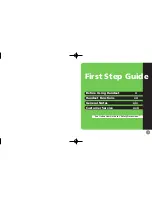
7
NOTE: Initialization may take several minutes to complete. The red and yellow LEDs will flash together
during initialization. Do not leave the installation until the red and yellow LEDs have stopped flashing.
(If only the yellow LED is flashing, there is a Communicator Trouble and the Green LEDs are not valid
for the Communicator Placement Test). See Table 6 for assistance in troubleshooting Communicator
Troubles.
6. Perform the Communicator Placement Test on page 8.
NOTE: The Communicator Placement Test must be successful before continuing to the next step.
7. Establishing a communication channel between the Communicator and the panel is critical to ensuring the
desired operation of the two units. The following steps must be completed during the on-site installation. Pro-
gram the following at the panel to ensure that the Communicator and the panel will work together as
intended. Panel Sections must be programmed at the panel keypad. Enter
[*][8][Installer Code] [Section
Number]
for panel programming. Record any values that are modified from their default, in the appropriate
Programming Worksheets for the Panel and Communicator.
NOTE: When programming Toggle Options, the toggle is ON when the number is displayed and OFF
when the number is not displayed. (e.g., [1---5---], Toggle Options 1 and 5 are ON, all others are OFF).
8. Panel Section [167] GPRS/Ethernet Interface Communications ‘Wait for ACK’: Program value as:
060
(seconds).
9. When the communicator is installed with the PC9155 panel, 4 telephone number are available to backup
one another. You can set up these 4 telephone numbers to perform in one of two ways: Backup dialling or
Alternate dialling.
a.
Backup dialling
: each of the 4 telephone numbers will make 5 dialling attempts in turn, before an FTC
trouble is displayed on the keypad.
b.
Alternate dialling
: each telephone number makes 1 dialling attempt before moving on to the next num-
ber, cycling through each of the 4 numbers for a total of 5 times each. If all 4 numbers fail the 5 attempts,,
an FTC trouble is displayed on the keypad.
10.Panel Sections [301], [302], [303], and [305] can be configured as Primary communication paths.
a. Panel Sections [302], [303], and [305] may also be configured for backup or redundant communications
by using Panel Sections [383] or [351] - [376]. Refer to the PC9155 panel Installation Manual for more
information.
b. If a valid phone number is programmed, communications will use Public Switched Telephone Network
(PSTN). Entering a 4 digit hexadecimal value for a telephone number will change the call routing as
determined by the number programmed:
DCAA
F:
Internal (All Receivers). Signals will be routed depending on Section [851] [006] programming.
DCBB
F:
Ethernet Receiver 1 (Primary). (TL260GS/TL265GS only).
DCCC
F:
Ethernet Receiver 2 (Backup). (TL260GS/TL265GS only).
DCDD
F:
GPRS Receiver 1 (Primary).
DCEE
F:
GPRS Receiver 2 (Backup).
NOTE: Add a single ‘F’ as a suffix to the number to populate the unused remainder of the 32 charac-
ter field.
11.Panel Section [350]: If any of the phone numbers have been programmed as DCAA, DCBB, DCCC, DCDD,
or DCEE, panel Section [350] must be set to [04] if SIA format or [03] if Contact ID format.
12.Panel Section [382]: Toggle Option [5], ‘GS/IP Module Enabled’, must be set to
ON
. If this option is OFF, the
yellow status LED on the Communicator will indicate ‘Panel Supervision Trouble’ (2 flashes) and the unit can
not be programmed via PC-LINK cable.
13.Panel Section [401]: Toggle Option [1] must be set to
ON
in order to perform panel DLS session through
GPRS or Ethernet.
NOTE: Keep a record of the SIM card telephone number, it is required by users for SMS Command
and Control functions. Due to the nature of the SIM card activation process with GSM network carri-
ers, it can take up to 24 hours for SIM card activation to be complete.
Power Save Feature (GS2065/TL265GS only)
The GS2065/TL265GS
models have a power
save mode feature. If
there is an AC power
loss on the PC9155 con-
trol panel, the system will
enter power save mode
to extend battery dura-
tion. During power save
mode, the Ethernet func-
tionality is turned OFF
and will only turn ON
when an event needs to
be transmitted, DLS ses-
sion is requested via
SMS, or for firmware
upgrade is required.
•
When in power save
mode, incoming DLS
connections will not
be possible.
•
Outgoing SMS initi-
ated DLS sessions
are possible while the
unit is in power save
mode.
•
The Link activity LED on the NID will also be OFF when the unit is in power save mode.
Figure 5 GS2065/TL265GS Wiring Diagram
DG009392
Network Connection
(Model TL265GS)
U
s
e only CAT5 c
ab
le. S
u
pervi
s
ed.
PC9155D
PC9155G
AUDIO/DEFAULT
DSC
UA557
PC-LINK
GND
SH
LD
TL265GS / GS2065
T-1
R-1
TIP RING IO2 IO1 -AUX AUX+ AC
AC
NOTE:
Model PC9155D
us
e
s
the d
ua
l
a
l
a
rm
comm
u
nic
a
tor GSM-GPRS/IP model TL265GS.
Model PC9155G
us
e
s
the GSM-GPRS only
comm
u
nic
a
tor, model GS2065.
NOTE:
For wiring det
a
il
s
for the PC9155,
refer to In
s
t
a
ll
a
tion M
a
n
ua
l p/n 29007510.
UA55
8
GSM R
a
dio
SIM C
a
rd
Holder
RED
1
Red
Wire
St
a
t
us
LED
s
INPUT RATINGS (from PC-Link)
11.1V - 12.6 V
DC
100mA
s
t
a
nd
b
y; 400mA Al
a
rm
Hardware
Default
Lock
RJ-45












































